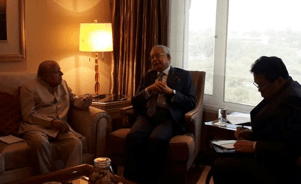MALAYSIA

ENSURING SUSTAINANCE OF MALAYSIA’S RUBBER PLANTATIONS
Even before I went to IRRI, I had good contacts in Malaysia as I was a member of the Malaysian Rubber Research Development Board.
I had direct contact with Prime Minister Mahathir, who required me to come up with a strategy on how much area his government should allocate for rice cultivation, as there was increased pressure to devote land to plantation crops. The combination of dwarf coconut, pineapple and cocoa was particularly spreading fast and this posed as a threat to land dedicated to the cultivation of rice. I chaired a small committee in 1986 and Anwar Ibrahim, the then Agriculture Minister, was a member who attended all the meetings. We decided to recommend that 25 per cent of the requirement of rice should be home grown and 75 per cent should be imported from Thailand on a long-term basis.
We recommended that Malaysia should grow the dwarf coconut from the Ivory Coast, where the French had previously developed it. Mahathir also promoted rubber plantations. The yield the rubber plants produce usually drops after about 20 years. So, it was decided that after 20 years, they would continue extracting as much latex as they can and, at the same time, the rubber wood would be used to make good furniture. Between, instead of the old rubber plants, new rubbers were planted. Many of these influential and impactful steps were taken because of the country’s public policy and the direct access to, and intervention of the Agriculture Minister and the Prime Minister.

 M S Swaminathan Research Foundation
M S Swaminathan Research Foundation Phone :
Phone :